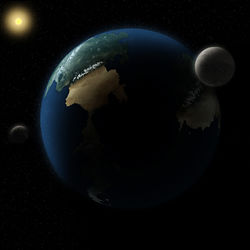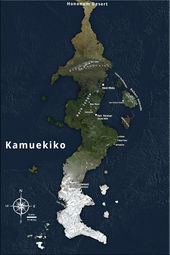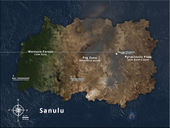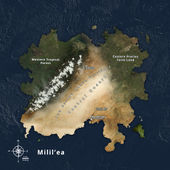
|
Under Construction This page seems to be Under Construction. Watch out for large groups of Rebel fighters.
After construction is complete, please remove this message.
|
Template:HOUWikiUpdate

|
| New Tython (Harakoa)
|
|
Outer Rim Territories
|
|
Esstran sector
|
|
DLSCX-2298 (Yhi System)
|
|
1: Yhi
|
|
2: Iah, Kalfu
|
|
1.1 AU
|
|
389 Standard Days
|
|
Terrestrial
|
|
9,645 km
|
|
Type I
|
|
-20 to 48˚C
|
|
1.23 x Standard
|
|
Variable
|
|
|
|
Harakoans
|
|
Humans, Mon Calamari, Various Species
|
|
Basic, Harakose
|
- ~100,000 Human Colonists
- ~50,000 Mon Calamari Colonists
- ~12,000 Bothan Colonists
- ~300,000,000 Natives
|
|
Menat Ombo, Dac Compound
|
|
None
|
|
None
|
|
Odan-Urr
|
New Tython, known as Harakoa to the indigenous population, is the home planet of House Odan-Urr. Once a world of tribal and colonial strife, it fell in late 36 ABY to the Thuron Monarchy before being liberated by the Jedi. Today it exists as a planet of peace, where nations strive together toward a better and brighter future - without the abandonment of the planet's rich heritage.
Please bear with the Odan-Urr Summit while we work on updates to this page. Thank you!
History
This section is in the shipyards for repair. Check back soon!
Nations and Territories
This section is in the shipyards for repair. Check back soon!
Geography
There are four continents on New Tython; ranging from the gigantic continent of Owyhyee in the North West Hemisphere, which has a wide range of different climates (including deserts and grassy plains), to the smallest continent of Sanulu covered in mountain ranges peppered by dozens of semi-active volcanoes, resulting in the region being christened "The Inferno" by the various native populations.
Apart from Owyhyee and Sanulu, there are the two other continents of Kamuekiko and Milil’ea, as well as various islands spread across the oceans of the planet. One such grouping of islands approximately 250 kilometers off the west coast of Sanulu has never been colonized by native or immigrant populations, owing primarily to the fact that they are composed almost entirely of volcanic rock and glass and have no native wildlife upon them.
Owyhyee
(pronounced: "O-wih-hee-ay")
 Owyhyee
Owyhyee
Owyhyee is situated in the North West Hemisphere and is 1,620 miles from east coast to west coast, and 1,450 miles from north coast to south coast. It is sparsely populated, encouraging a nomadic lifestyle, though it also houses the planetary seat of government, Menat Ombo. The vast grasslands of Owyhyee is home to countless species of both flora and fauna. Vast herds of beasts which the natives hunt for food and clothing support approximately 500,000 indigenous people divided into hundreds of small communities. Several major rivers flow across this area, fueled by countless snow melt tributaries nestled deep in the continent's central mountain range. The grasslands in the east of the continent are split from the Honunom desert by a small mountain chain that reaches an average height of 2,000 meters. The vast height of the mountains discourages the natives from passing over them, however notable villages in the primary passes to the Honunom desert command trade through the region.
The Honunom desert reaches a max temperature of 48 degrees Celsius during the day in summer, but is prone to plunging well below freezing at night. Life is sparse in the desert, as is water, but there are several oases spread across the desert where they tap into the deep water table.
On the other side of the desert, if one manages to travel through it, is another expanse of grassland punctuated by forests which have been partially cleared and plundered to make room for the capital of Menat Ombo and the dozens of colonial and sedentary farms clustered around the small city. The capital is situated on the banks of the vast, turbulent River Sabina, which is prone to seasonal flooding, and eventually flows into the Bythic Ocean.
Kamuekiko
 Kamuekiko
Kamuekiko
(pronounced: "Ka-mue-kee-ko")
Situated directly South of Owyhyee, Kamuekiko is attached to the Northern continent by a narrow isthmus of desertified land. The continent itself is covered in tropical rainforest which eventually tapers into a mountain range. Despite the relative geological calmness, there are occasional earthquakes in the area. To the southwest the land is dominated by rocky plains, where limestone and chalk outcroppings are common.
The rainforests are largely unexplored by the colonists or Jedi due to the dense undergrowth which prevents travel of large groups. However, drawing from the superstition of populations bordering the area, one can assume there are tribes living within. The coasts have many natural (including some deep water) harbors. The rocky plains below the rainforest have a weakened presence of natives due to the established colony of Mon Calamarians. Unable to compete with the settlers, the natives have migrated further north towards the edges of the rainforests.
The isthmus between Owyhyee and Kamuekiko is part of the Honunom desert, which often discourages migration between the two continents.
Kamuekiko is a narrow continent, but quite long, stretching down to the 48th degree of longitude. This is the cause of the extremely cold weather in winter. The continent measures 2,764 miles from the isthmus between Owyhyee and Kamuekiko to the southern tip. From the east to west coasts, it measures only 800 miles at the widest point. Off the west coast of Kamuekiko lays an archipelago, consisting of hundreds of tiny islands.
Sanulu
(pronounced: “San-u-lu")
 Sanulu
Sanulu
Situated in the North Eastern Hemisphere of New Tython, Sanulu is the smallest of the four continents of New Tython, consisting of an extreme climate due to the constantly erupting volcano-networks permeating its rugged geography. The constant flow of lava increases the size of the continental shelf by up to five miles per year (depending on yearly flow-size). Due to the ash thrown up into the atmosphere, the air above the interior of the continent is high in nitrogen and carbon dioxide making it unsuitable for sentient habitation, though there are minor settlements on the more temperate and geologically calmer coastlines.
Sanulu is small in size compared to the other three continents, measuring only 800 miles from its east to west coast and 369 miles from its north to south coast. However, it is growing each year. It is calculated that if it continues to grow in size at its current pace, the continent will rival Kamuekiko in size in approximately 3,000 years time.
Milil’ea
(pronounced: "Me-lil-ee-ah")
 Milil'ea
Milil'ea
Milil'ea is the second largest continent of New Tython and it has the biggest number of different habitats within its interior. These range from perpetual tundra in the far south of the continent, to desert within the centre of the continent. In the north of Milil'ea is a vast grassland area, that is dotted with signs of glaciation in the past, fallen stones that had been dragged hundreds of miles from their source.
To the west is a large rainforest, where the native species prosper, the area unexploited by the settlers that descended upon New Tython. The rainforest abruptly tapers into a large mountain range that are the result of shifting tectonic plates hundreds of millions of years ago, however earthquakes do habitually occur, causing landslides and flooding when the rains come.
To the south of the mountain range lies the vast tundra, populated mainly by migrating tribes that follow the vast herds of the native arctic species.
The east side of Milil'ea is heavily populated by farming communities, taking advantage of the large amount of rivers in the east of Milil'ea. Dotted in between the farms are a series of woodlands and lakes that attract Mon Calamarian settlers.
The desert in the centre of Milil'ea is slowly expanding to the east as desertification occurs due to the over-farming of the land by the settlers, a problem that the Acolytes of Odan-Urr hope to stem.
Milil'ea is 1,670 miles from north to south at its widest point, while it measures 1,540 miles from east to west, a truly vast continent.
Treaty of Menat Ombo
Political Landscape
Economy